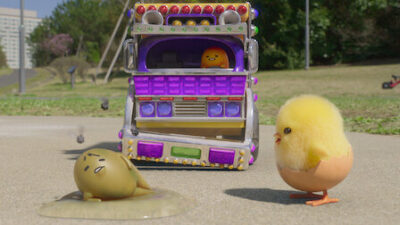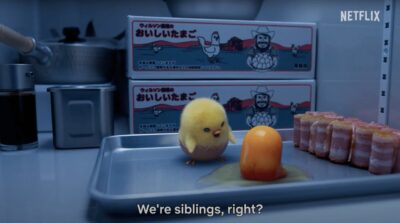Gudetama, stylized in all lowercase and originating from Japan, is a cartoon character crafted by the renowned company Sanrio in 2013. This character embodies the essence of a perpetually tired and apathetic anthropomorphic egg yolk. Its name, “Gudetama,” cleverly merges the Japanese words for lazy (ぐでぐで, gudegude) and egg (たまご, tamago). Gudetama was brought to life by Sanrio designer Emi Nagashima, who goes by the pseudonym Amy.
Initially intended for a preadolescent audience, Gudetama quickly transcended age barriers, resonating strongly with teenagers and adults alike. Its portrayal of the struggles inherent in modern society struck a chord with audiences, leading to its widespread popularity among millennials. By 2019, Gudetama had secured its position as Sanrio’s third most profitable character.
Gudetama’s influence extends far beyond its origins, permeating various forms of media and consumer products. From appearing in an animated morning show on TBS in Japan from 2014 to 2020 to headlining its own Netflix series, “Gudetama: An Eggcellent Adventure,” in 2022, this lazy egg has solidified its place in popular culture. Additionally, video games and comics featuring Gudetama have been developed, expanding its reach even further.
The character’s impact isn’t confined to entertainment alone. Gudetama-themed decor has graced airplanes and trains, while restaurants have delighted patrons with dishes inspired by the lovably lethargic egg. Its image adorns a wide range of merchandise, including apparel, stationery, and toys, further cementing its status as a beloved cultural icon.
Creation and history
The creation and history of Gudetama trace back to 2013 when the Japanese company Sanrio introduced this quirky character to the world. Gudetama, stylized in all lowercase, was the brainchild of Sanrio designer Emi Nagashima, who adopted the pseudonym “Amy” for this project.
Gudetama is unlike any other character in the Sanrio lineup, as it takes the form of a perpetually tired and apathetic anthropomorphic egg yolk. The name “Gudetama” is a clever fusion of two Japanese words: “gudegude,” meaning lazy, and “tamago,” meaning egg. This portmanteau perfectly encapsulates the essence of the character—a symbol of laziness and nonchalance.
Initially targeted at a preadolescent demographic, Gudetama quickly transcended age boundaries, resonating with teenagers and adults alike. Its relatable portrayal of the challenges of modern-day life struck a chord with audiences, leading to its adoption by millennials. By 2019, Gudetama had risen to become Sanrio’s third most profitable character, showcasing its widespread appeal and enduring popularity.
Gudetama’s presence expanded beyond traditional media, with the character featuring in an animated morning show on TBS in Japan from 2014 to 2020. In 2022, Gudetama ventured into the realm of streaming entertainment with its own Netflix series, “Gudetama: An Eggcellent Adventure,” further solidifying its status as a cultural icon.
The character’s influence extends to various forms of merchandise, including apparel, stationery, toys, and more. Its distinctive design and universal appeal have made it a favorite among collectors and enthusiasts worldwide.
Beyond its commercial success, Gudetama represents more than just a cartoon character—it embodies a subtle philosophy that resonates with many. Through its laid-back demeanor and relatable struggles, Gudetama reminds us to embrace our imperfections, find humor in life’s challenges, and take moments to simply be lazy—an eggcellent lesson indeed.
Characters
Gudetama, the beloved lazy egg character created by Sanrio in 2013, resides in a whimsical world populated by a variety of characters. The central figure, Gudetama, epitomizes laziness and apathy, often depicted in various poses within its eggshell. Accompanying Gudetama are the Gudegude Friends, including Shirogoma, Nisetama-san, and Mameshiba-san, each adding their own quirks to the mix. Other characters like Tamago no Kara represent energy and vitality, providing contrast to Gudetama’s lethargy. Mama Gudetama serves as a nurturing figure, while food items like Bacon and Sausage add food-related humor to the mix. Together, these characters create a rich and playful world, where Gudetama’s laziness takes center stage amidst a backdrop of food-related antics and cozy eggshell settings.
Culture
Gudetama’s widespread appeal can be attributed to two key factors deeply rooted in Japanese culture: the concept of kawaii (cuteness) and the significance of food. Unlike traditional cute characters, Gudetama falls into the category of kimo-kawaii, or “gross-cute,” due to its depressive demeanor and constant complaints about life’s hardships. This unique twist resonates with audiences, particularly millennials, who may feel disillusioned with the pressures of work and societal expectations. Gudetama’s popularity reflects a nuanced form of self-expression, providing an outlet for emotions in a culture where verbalizing feelings can be challenging.
Furthermore, Japan’s rich food culture plays a significant role in Gudetama’s appeal. While previous characters like Anpanman have featured food themes, Gudetama’s focus on eggs holds a special resonance. According to Emi Nagashima, the character’s designer, Gudetama’s inspiration stems from the Japanese breakfast staple of tamago kake gohan (raw egg over rice), symbolizing the start of a new day for Japanese workers. This symbolism extends further, with Gudetama representing the selective nature of employment and capitalist values, where individuals are valued based on their contributions to society. Just like eggs, people are expected to provide their best efforts, with Gudetama serving as a reflection of society’s expectations and the struggles of modern-day workers. Through its symbolic resonance and relatable themes, Gudetama has captured the hearts of audiences and achieved widespread popularity in Japan and beyond.
Meaning
Gudetama shows how complex Japan’s “kawaii” culture has become, and how basic American cuteness is.
Gudetama serves as a fascinating example of the evolving complexity of Japan’s “kawaii” culture compared to the more straightforward perception of cuteness in American culture. In Japan, the concept of kawaii encompasses a broad spectrum of characteristics beyond traditional notions of adorable and positive imagery. Gudetama’s portrayal as a lazy and melancholic egg represents a subcategory of kawaii known as kimo-kawaii, or “gross-cute,” which blends cute elements with unconventional or even unsettling traits. This departure from the conventional notion of cuteness illustrates how Japan’s kawaii culture has evolved to embrace and appreciate complexity, ambiguity, and even darker themes.
On the other hand, American cuteness tends to adhere more closely to traditional standards, focusing on wholesome and cheerful imagery without delving into the same depth of complexity seen in Japanese kawaii culture. While there are certainly examples of characters and concepts that push boundaries in American pop culture, they often remain on the periphery and may not achieve the same level of mainstream success or recognition as their Japanese counterparts.
In summary, Gudetama’s character exemplifies the multifaceted nature of Japan’s kawaii culture, showcasing how it has expanded to incorporate a wider range of emotions and aesthetics. This complexity stands in contrast to the more straightforward and traditional perception of cuteness prevalent in American culture.
In conclusion, Gudetama transcends the boundaries of traditional cuteness, offering a glimpse into the complex and nuanced world of Japan’s kawaii culture. Its portrayal as a lazy egg with a penchant for melancholy challenges conventional notions of adorableness, yet resonates deeply with audiences worldwide. Through Gudetama, we not only find humor and charm but also a reflection of society’s attitudes towards work, mental health, and self-expression.
To explore more of Gudetama’s world and discover an array of delightful merchandise featuring this lovably lethargic character, visit Gudetama Store. Dive into the whimsical universe of Gudetama, where laziness meets cuteness in the most unexpected and endearing ways.






